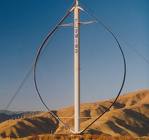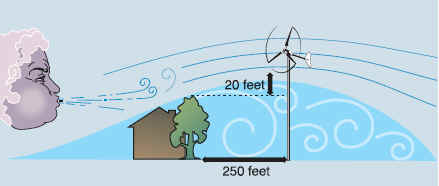|
How Wind Turbines Work
Wind is a form of solar energy. Winds are caused by the uneven heating
of the atmosphere by the sun, the irregularities of the earth's surface,
and rotation of the earth. Wind flow patterns are modified by the earth's
terrain, bodies of water, and vegetation. Humans use this wind flow, or
motion energy, for many purposes: sailing, flying a kite, and even generating
electricity.
The terms wind energy or wind power describe the process by which the
wind is used to generate mechanical power or electricity. Wind turbines
convert the kinetic energy in the wind into mechanical power. This mechanical
power can be used for specific tasks (such as grinding grain or pumping
water) or a generator can convert this mechanical power into electricity.
So how do wind turbines make electricity? Simply stated, a wind turbine
works the opposite of a fan. Instead of using electricity to make wind,
like a fan, wind turbines use wind to make electricity. The wind turns
the blades, which spin a shaft, which connects to a generator and makes
electricity. Take a look inside a wind turbine to see the various parts.
View the wind turbine animation to see how a wind turbine works.
Types of Wind Turbines
Modern wind turbines fall into two basic groups: the horizontal-axis
variety, as shown in the photo, and the vertical-axis design,
like the eggbeater-style Darrieus model, named after its
French inventor.

Horizontal-axis wind turbines typically either have two or three blades.
These three-bladed wind turbines are operated "upwind," with
the blades facing into the wind. The other common wind turbine type is
the two-bladed, downwind turbine. Horizontal axis turbines are the most
common type used today. DOE research focuses on development of horizontal
axis turbines.
Sizes of Wind Turbines
Utility-scale turbines range in size from 50 kilowatts to as large as
several megawatts. Larger turbines are grouped together into wind farms,
which provide bulk power to the electrical grid.
Single small turbines, below 50 kilowatts, are used for homes, telecommunications
dishes, or water pumping. Small turbines are sometimes used in connection
with diesel generators, batteries, and photovoltaic systems. These systems
are called hybrid wind systems and are typically used in remote, off-grid
locations, where a connection to the utility grid is not available
Advantages
Wind energy is fueled by the wind, so it's a clean fuel source. Wind energy
doesn't pollute the air like power plants that rely on combustion of fossil
fuels, such as coal or natural gas. Wind turbines don't produce atmospheric
emissions that cause acid rain or greenhouse gasses.
Wind energy is a domestic source of energy, produced in the United States.
The nation's wind supply is abundant.
Wind energy relies on the renewable power of the wind, which can't be
used up. Wind is actually a form of solar energy; winds are caused by
the heating of the atmosphere by the sun, the rotation of the earth, and
the earth's surface irregularities.
Wind energy is one of the lowest-priced renewable energy technologies
available today, costing between 4 and 6 cents per kilowatt-hour, depending
upon the wind resource and project financing of the particular project.
Wind turbines can be built on farms or ranches, thus benefiting the economy
in rural areas, where most of the best wind sites are found. Farmers and
ranchers can continue to work the land because the wind turbines use only
a fraction of the land. Wind power plant owners make rent payments to
the farmer or rancher for the use of the land.
Disadvantages
Wind power must compete with conventional generation sources on a cost
basis. Depending on how energetic a wind site is, the wind farm may or
may not be cost competitive. Even though the cost of wind power has decreased
dramatically in the past 10 years, the technology requires a higher initial
investment than fossil-fueled generators.
The major challenge to using wind as a source of power is that the wind
is intermittent and it does not always blow when electricity is needed.
Wind energy cannot be stored (unless batteries are used); and not all
winds can be harnessed to meet the timing of electricity demands.
Good wind sites are often located in remote locations, far from cities
where the electricity is needed.
Wind resource development may compete with other uses for the land and
those alternative uses may be more highly valued than electricity generation.
Although wind power plants have relatively little impact on the environment
compared to other conventional power plants, there is some concern over
the noise produced by the rotor blades, aesthetic (visual) impacts, and
sometimes birds have been killed by flying into the rotors. Most of these
problems have been resolved or greatly reduced through technological development
or by properly siting wind plants.
What You Need to Make Wind Work
First, and most importantly, you'll need a place to put the wind turbine.
The site should be well exposed to the wind and free of any obstructions
within 200 feet. If there are any nearby trees, the turbine must be mounted
on a tower at least 20 feet above the tallest tree. And keep in mind that
trees often grow taller, particularly softwoods.
Next, determine if you have enough wind. Hybrid power systems for living
off-the-grid require less wind than those that have to compete directly
with utility power. If possible, measure the wind at your site with a
recording anemometer over several seasons. We offer the very moderately
priced (for a recording anemometer) Totalizer 2100 in the following Product
Section.

Next you'll need a reliable wind turbine. There are several on the market
but we offer only ones that we've found to be the most reliable. The appendix
of Wind Power for Home & Business (item #80-192, $35) contains an
extensive and up-to-date list of wind turbine manufacturers worldwide.
The appendix lists most available wind turbines, including micro turbines,
small wind turbines, and medium-sized wind turbines like those used in
California wind farms.
After these first three steps have been completed, you'll need to determine
the height of your tower. The "taller the tower the greater the power"
is an adage that has been proven time and again. For micro turbines towers
of 20-50 feet tall are sufficient. Small wind turbines typically justify
towers 100 feet tall or more, depending upon the terrain.
And don't forget the paperwork. Check if there are any regulations governing
wind turbines in your area and apply for the necessary permits.
Typical Costs
The cost of a wind power system includes the cost of the wind turbine
itself, the tower, and its installation. The total cost of micro turbines
can be as little as $500-$1,500 depending upon the tower used and its
height. Bigger machines are more costly, but can be more cost-effective.
Whether wind energy is a good investment at your site depends on a host
of factors, including the average wind speed, the installed cost, inflation,
utility buy back rates, taxes, and so on. (For more on how to determine
cost-effectiveness see Wind Power for Home & Business, especially
the chapter "Economics: Does Wind Pay?") If the wind turbine
will be part of an off-the-grid power system and there is at least an
8 mph average wind speed, a wind turbine will nearly always make economic
sense.
|